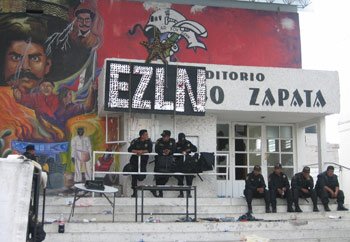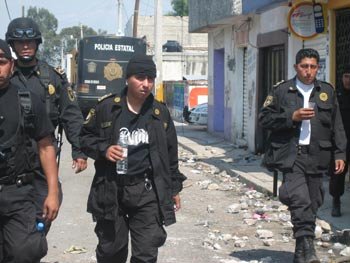


“Hard Line” or Witch Hunt?
The Reality of the Atenco Violence Amidst Media and Government Lies
By Quetzal Belmont
The Other Journalism with the Other Campaign in San Salvador Atenco
May 9, 2006
MEXICO CITY AND SAN SALVADOR DE ATENCO: At about six o’clock in the afternoon of May 4th, images of state and federal police attacking the community of San Salvador de Atenco, located only 20 minutes from the capital, began to appear on television.
The objective of the police operative was to rescue 11 police who were being held by residents of Atenco, all of whom had been captured the day before in the confrontation between police and Atenco locals.
 Photo: D.R. 2006 Amber Howard |
We are reminded of witch hunts. Ignacio del Valle, community leader in Atenco, is now being held prisoner in a maximum-security prison; his daughter, América del Valle, is in hiding with an arrest warrant over her head. Journalists working with independent media have been detained, and foreign journalists have been deported. Valentina Palma, a Chilean documentary filmmaker, was sent back to her country even though a video clearly shows that she was working at the time of her arrest, and despite a judge’s order to delay the deportation. Once again the written word means nothing in Mexican law.
At dawn on May 4, at about 4:00 AM, bells and rockets were heard throughout the town of Atenco, warning residents of a possible police attack or “operation.” One resident said, in an interview, that they were exhausted by the previous day’s confrontation, and what happened on Thursday is that “they got us while we were sleeping.”
 Arrest in Atenco, May 4 Photo: D.R. 2006 Ratón Maicero |
The night before, people arrived from diverse sectors of society, mostly from in and around the state of Mexico. Among them were students and union members who came to act as observers for the residents of Atenco, so that they wouldn’t be subjected to violence and repression yet again.
But the observers became the observed, violently and forcefully attacked.
Here it is necessary to step back a moment. People have been injured on both sides (police and residents of Atenco) and we have seen powerful images of senseless beatings by both sides. But a fundamental issue, one that transcends all else, is the disparity between the two sides — in actual numbers, but also in the nature of the weapons used, whether for attacking or defending (a question of perspective).
After the federal police cleared the way for the police forces, they confronted the residents of Atenco and others who had come there, launching so much tear gas that the town was engulfed in a cloud, making it difficult to see. This allowed some people the opportunity to seek out hiding places without being seen by the police, while others were overcome by the gases and arrested.
On into the afternoon, the police went from house to house, smashing windows, breaking down doors, arresting more and more people.
Meanwhile, in different parts of Mexico City, protesters began to fill the streets and to blockade the highways that lead in and out of the capital.
The story continues…
The Peoples’ Front in Defense of the Land (FPDT), an organization led by Ignacio del Valle, sent out a communiqué denouncing the increased use of force and the destruction of homes in the community, as well as the growing number of people who had suffered serious injuries without any access to medical care.
 Photo: D.R. 2006 Amber Howard |
Alexis Benhumea is an economics student at the National Autonomous University of Mexico. He is twenty years old, and had recently been accepted into a second degree program in mathematics. For the last eight years he has also performed classical and contemporary dance.
In the middle of the riot, a teargas canister struck Alexis in the left temple, causing two skull fractures, one of which was exposed. After he was hit, he was taken to the home of a couple who opened their doors. Twenty-three people were hiding in this two-room house. They decided to leave one of the rooms for Alexis, his father, and a doctor. The other twenty people went to hide in the other room. Because of the violence and persecution in the streets of Atenco, it was difficult to get medical assistance for Alexis. When asked why they didn’t get him to an ambulance sooner, people who were with him said that they had no choice; that if they had gone out for help, the police would have entered the house to arrest everyone. They say they would have been beaten, which would have exacerbated Alexis’ already tenuous condition, and that Alexis was completely immobile.
While everyone remained hiding inside the house, they could hear the sound of people being beaten and dragged through the streets. They could hear screams, windows breaking, banging on doors, and the endless launching of tear gas.
By late afternoon, the situation had begun to “calm down.” Walking through the streets one saw only police, burned tires, destroyed cars, and garbage. In addition to the strange smell, the air carried a tense calm.
At 5:00 PM, a large part of the police forces began to withdraw. Those who had been hiding in the house with Alexis seized the moment and began to sneak out. Alexis had been in the house for almost eleven hours, without the necessary medical attention. They had him laid out on the floor with a cloth around his head to slow the bleeding. As the hours passed, he had begun to suffer symptoms such as vomiting, low blood pressure, pallor, and arrhythmia.
An ambulance was needed to get Alexis to the hospital, but it never arrived. Finally at 5:30 PM, they put him in a collective taxi to take him to a nearby hospital. But by then, he was already in a coma, with very limited chances for survival.
Ángel Benhumea, Alexis’ father, is the union representative for the teachers of the National Autonomous University of Mexico (UNAM), and was the speaker on May 2nd, when Delegate Zero visited the UNAM.
Within this context, questions arise; were these isolated events that took place these last few days? Were the people of Atenco truly considered the minority? Did the Other Campaign pass unnoticed? Can we really say that repression hasn’t carried out by the state and federal government?
Click here for more Narco News coverage of Mexico
Lea Ud. el Artículo en Español
Lesen Sie diesen Artikel auf Deutsch
Legga questo articolo in italiano
- The Fund for Authentic Journalism
For more Narco News, click here.




